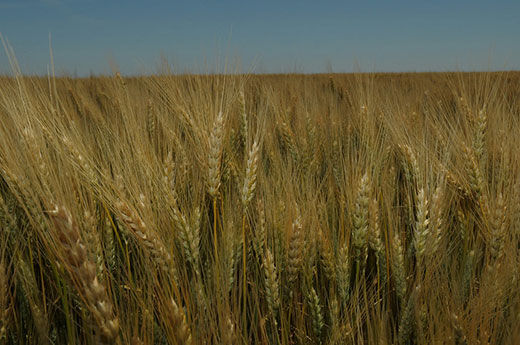Publication takes a look at threats to Kansas’ most popular varieties
In Kansas and other wheat-growing states, the tools of the trade include a planter, combine and a grain bin.
But ask most farmers, and they’re also likely to have a reliable source for information on wheat diseases and insects that threaten their crop. Sometimes, that source is neatly tucked into a hip pocket or the truck’s glove box.
For more than 30 years, Kansas State University has been publishing a report that takes a look at disease and insect trends in the state’s wheat crop.
“This is a summary of multi-year data about disease and insect reactions of the most popular varieties – and some historical varieties—that are grown here in Kansas. We also include agronomic traits of these varieties, including height, maturity, straw strength and drought tolerance,” said K-State Research and Extension wheat disease specialist Kelsey Andersen Onofre.
The 2021 Wheat Variety Disease and Insect Ratings is now available online through the K-State Research and Extension bookstore. The publication is available free online.
Anderson Onofre said the publication includes a broad view of wheat varieties in the state that may be “above average for certain diseases in parts of the state as well as varieties that need to be managed more intensely.”
She said that by monitoring the wheat crop, K-State researchers are able to not only track disease and insect pressure in the state, but also compare that with varieties that perform well against disease or insects, and treatments for the crop.
“We put these varieties to the test and put a lot of eyes on them before we include them in our annual report,” Andersen Onofre said.
“This is a year when we certainly had high stripe rust pressure in parts of the state,” she added. “We did get a lot of stripe rust notes, both from inoculated nurseries and from various high natural pressure locations.”
This year, K-State was also reporting “high concern” for Fusarium head blight and wheat streak mosaic virus. Along with stripe rust, “those are the Big Three that really stood out as problematic in pockets of the state this year,” according to Andersen Onofre.
Fusarium head blight was more common in western Kansas due to higher-than-normal moisture.
“We don’t see that disease as often out west because it needs moisture,” Andersen Onofre said. “Now we know that pathogen is there, so when there is another wet year, we know that a fungicide application at flowering may be necessary.”
Andersen Onofre said Fusarium head blight is a good example of a disease that requires a marriage, of sorts, of the two most effective ways to prevent disease in wheat.
“Selecting a variety with intermediate disease resistance plus a fungicide is really the best way to control Fusarium head blight,” she said. “Neither of those two work well alone, but putting them together—especially if you have high infection – is where you’re going to see the most control in those high pressure years.”
“It’s always good to think about resistant varieties; that’s the tool we always have in the bag that you don’t have to worry about later on. But a timely fungicide decision can be married well with a good variety.”
More information on K-State’s crop research, as well as many other agronomic topics, is available each week in the Agronomy eUpdate, available online from the university’s Department of Agronomy.



